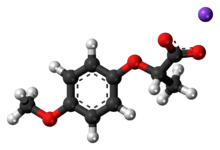Lactisole
Lactisole is a carboxylic acid salt. Like gymnemic acid, it is a sweet inhibitor or taste modifier.[1]
 | |
 | |
| Names | |
|---|---|
| IUPAC name
Sodium 2-(4-methoxyphenoxy)propanoate | |
| Other names
Lactisole; ORP 178; Propanoic acid, 2-(4-methoxyphenoxy), sodium salt | |
| Identifiers | |
3D model (JSmol) |
|
| ChemSpider | |
| ECHA InfoCard | 100.123.510 |
PubChem CID |
|
| UNII | |
CompTox Dashboard (EPA) |
|
| |
| |
| Properties | |
| C10H11O4Na | |
| Molar mass | 218.188 g/mol |
| Appearance | white to pale cream, crystalline solid |
| Melting point | 190 °C (374 °F; 463 K) |
| Soluble in water and propylene glycol, slightly soluble in fat and miscible at room temperature in ethanol | |
Except where otherwise noted, data are given for materials in their standard state (at 25 °C [77 °F], 100 kPa). | |
| Infobox references | |
Chemistry
Chemically, lactisole is the sodium salt of 2-(4-methoxyphenoxy)propionic acid.
Natural occurrences
This acid has been isolated from roasted Colombian arabica coffee beans.[2]
Anti-sweet properties
At concentrations of 100–150 parts per million in food, lactisole largely suppresses the ability to perceive sweet tastes, both from sugar and from artificial sweeteners such as aspartame. A 12% sucrose solution was perceived like a 4% sucrose solution when lactisole was added. However, it is significantly less efficient than gymnemic acid with acesulfame potassium, sucrose, glucose and sodium saccharin. Research found also that it has no effect on the perception of bitterness, sourness and saltiness.[1] According to a recent study, lactisole acts on a sweet taste receptor heteromer of the TAS1R3 sweet protein receptor in humans, but not on its rodent counterpart.[3]
As a food additive
The principal use of lactisole is in jellies, jams, and similar preserved fruit products containing large amounts of sugar. In these products, by suppressing sugar's sweetness, it allows fruit flavors to come through. In the United States, lactisole is designated as generally recognized as safe (GRAS) by the Flavor and Extract Manufacturers Association (Fema number: 3773) and approved for use in food as flavoring agent[4] up to 150 ppm. Currently, lactisole is manufactured and sold by Domino Sugar and its usage levels are between 50 and 150 ppm.[5]
See also
References
- Kinghorn, A.D.; Compadre, C.M. (2001). Marcel Dekker (ed.). Alternative Sweeteners (Third Edition, Revised and Expanded ed.). New York. ISBN 0-8247-0437-1.
- Ivon Flament; Yvonne Bessière-Thomas (2002). "The individual constituents". Coffee flavor chemistry. John Wiley and Sons. p. 207. ISBN 0-471-72038-0.
- Jiang, P.; Cui, M; Zhao, B; Liu, Z; Snyder, LA; Benard, LM; Osman, R; Margolskee, RF; Max, M (2005). "Lactisole Interacts with the Transmembrane Domains of Human T1R3 to Inhibit Sweet Taste". Journal of Biological Chemistry. 280 (15): 15238–46. doi:10.1074/jbc.M414287200. PMID 15668251.
- JECFA "Specifications for Flavourings"
- Sugar sans sweetness - lactisole. Prepared Foods, May, 1995 by Fran LaBell Archived 2009-01-22 at the Wayback Machine